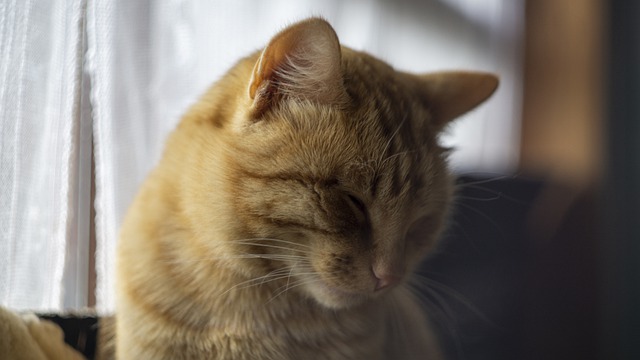FIV or Feline Immunodeficiency Virus is a virus that causes a state of immunosuppression in infected cats. FIV was first discovered in 1986 in the United States. This virus is part of the Retrovirus family and more precisely of the Lentivirus genus, so named because of the particularly slow evolution of the diseases they cause. They have the particularity to attack preferentially the cells of the immunity, notably the lymphocytes, and thus to weaken the immune defenses of the cat. In addition, these viruses have the ability to mutate rapidly and frequently, making the development of a vaccine against this pathogen problematic. The disease caused by FIV is a form of AIDS, similar to what exists in humans due to HIV.

How FIV is transmitted?
FIV can be transmitted between cats, but in no case can it cause AIDS in humans. It is a relatively non-contagious virus that is transmitted almost exclusively by biting between cats. This explains why infected cats are most often unneutered male cats, living in the wild, because they are the most quarrelsome. The FIV virus can also be transmitted in utero, i.e. an infected mother can transmit the disease to her kittens, but this mode of transmission is not frequent. Unlike HIV in humans, FIV is not transmitted sexually in cats. Once the cat is infected, it will remain a carrier of the virus for life, no cure is possible.
Development of the virus in cats
Once the virus enters the cat’s body, several stages are described in the evolution of the disease, which explains the chronology of the symptoms encountered. This is referred to as a progressive failure of the immune system. Because the disease develops slowly, cats experience a very progressive pathological evolution.
Stage 1 or primary infection
This phase often goes unnoticed and corresponds to the beginning of the infection. Symptoms are very frustrating and manifest themselves essentially by fever and a drop in form. An immune response is set up and antibodies appear but this is not enough to destroy the virus: the cat has become seropositive and potentially contaminating, for other cats only, and this permanently.
Associated symptoms: Cats that have just been infected may develop a transient fever, but this usually goes unnoticed. For infected kittens, the signs are mostly severe growth retardation.
Stage 2
This phase is said to be asymptomatic and lasts until about 5 years, or even 10 years. The immune system at this time is still able to fight the virus, which is present in small quantities but does not disappear. This phase is misleading because the cat seems healthy.
Associated symptoms: none.
At the end of this long period, the disease will enter its symptomatic phase, in 3 successive stages.
Stage 3
The virus starts to take over the immune system.
Associated symptoms: A persistent swelling of the lymph nodes may be noted. Other signs may be present such as fever or anorexia.
Approximately one-third of FIV-infected cats are brought to the veterinarian at this stage.
Stage 4 or pre-AIDS phase
The virus continues to progress while the immune system becomes increasingly weakened. Secondary bacterial infections take advantage of this to take hold.
Associated symptoms: as the immune system is weakened, the cat frequently develops secondary bacterial infections. One notes attacks of the oral cavity (stomatitis, gingivitis), attacks of the respiratory system (rhinitis, bronchitis, pneumonia,..), digestive or urinary disorders (cystitis), skin attacks (abscesses and pyoderma).
Stage 5 or AIDS stage (or terminal phase of the disease)
The cells of immunity are almost all destroyed consequently the cat cat catches infections called opportunistic.
Associated symptoms: Wasting is often a sign that the disease is entering its terminal phase, which can last from several months to several years. The cat presents a significant and rapid weight loss and many opportunistic infections develop (mycoses, severe coryzas, …). More rarely, nervous or ocular symptoms are present. FIV also increases the risk of tumors, especially lymphomas. Moreover, it has been shown that FIV can associate with another cat virus, FelV (feline leukemia virus) to induce the appearance of these tumors.
Diagnosis
This disease is expressed under various symptoms, it is not easy for the veterinarian to diagnose it. The recurrence of certain symptoms points the veterinarian in this direction.
When FIV is suspected, the veterinarian can verify its presence with a simple blood test and the use of a rapid kit (result in 10 minutes), or by sending the blood test to a laboratory.
Note: FIV is often associated with FelV in cats and these two viruses are most often tested together.
Treatment of FIV
There is currently no treatment or vaccine for FIV (in France). It is in fact a matter of treating secondary or opportunistic infections. This allows a significant improvement in the life of the sick cat. Prevention against FIV infection remains essential.
Prevention of FIV
First of all, neutering reduces the risk of catching the disease because cats are less likely to roam and fight, so there is less risk of being bitten by an infected cat. When taking in a found cat or a cat of unknown origin, it is a good idea to test the cat for FIV to determine its status. If you have other cats, it is best to quarantine the newest cat until you know its FIV status. If you suspect that there are FIV-infected cats in the vicinity of your home, avoid letting your cat out.
Living with an FIV-infected cat
It is perfectly possible to live with an infected cat. However, there are rules to follow:
- The cat should not leave the house to avoid the risk of infecting other cats in the area.
- Separate your infected cats from the other cats in your home to avoid spreading the disease.
- Keep in mind that the cat’s immune defenses are diminished and that it is therefore subject to the development of secondary diseases (abscesses, cystitis, etc.) on a chronic basis.
- Vaccinate the cat well to reduce the risk of catching other diseases. It is also necessary to treat him well against external parasites (fleas, ticks) and to deworm him regularly, even if he does not have access to the outside.
Remember that there is no specific treatment against the FIV virus, only treatments against secondary or opportunistic infections.
With proper care and attention, a cat infected with FIV can live a long and relatively healthy life.






